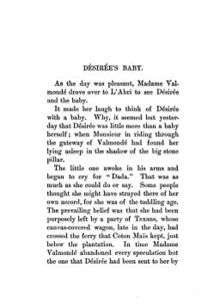Désirée's Baby
"Désirée's Baby" is a short story by the American writer Kate Chopin, published in 1893. It is about miscegenation in Creole Louisiana during the antebellum period.
| "Désirée's Baby" | |
|---|---|
| Author | Kate Chopin |
| Country | United States |
| Language | English |
| Genre(s) | Short story |
| Published in | Vogue |
| Publication date | 1893 |
Plot summary
Désirée is the adopted daughter of Monsieur and Madame Valmondé, who are wealthy French Creoles in antebellum Louisiana. Abandoned as a baby, she was found by Monsieur Valmondé lying in the shadow of a stone pillar near the Valmondé gateway. She is courted by the son of another wealthy, well-known and respected French Creole family, Armand. They marry and have a child. People who see the baby have the sense it is different. Eventually they realize that the baby's skin is the same color as a quadroon (one-quarter African)—the baby has African ancestry.
Because of Désirée's unknown parents, Armand immediately assumes that she is part black. Désirée denies the accusation. Désirée sends Madame Valmondé a letter in need of help which Madame Valmondé responds telling her that she can come back to her estate. Armand, scornful of Désirée, rejects her and insists that she leave. She takes their child and walks off into a bayou, never to be seen again. Armand burns all of Désirée's belongings, even the child's cradle, as well as all of the letters that she had sent him during their courtship. With this bundle of letters is also one written from his mother to his father, revealing that Armand is the one who is part black, by his mother's ancestry. Désirée's ancestry is never defined.
Publication history

"Désirée's Baby" was first published on January 14, 1893, in Vogue.[1] It first appeared under the title "The Father of Désirée's Baby" in a section called "Character Studies".[2] The same issue included Chopin's story "A Visit to Avoyelles"; both marked Chopin's first contributions to the magazine which would eventually publish 18 of her works before the end of the century.[3] "Désirée's Baby" was included in Chopin's collection Bayou Folk in 1894.
Themes and literary classification
Though Kate Chopin is usually considered to be a writer of American realism and naturalism, the story is difficult to classify, in part because it is extremely short. The story leaves the moral conclusion up to the reader, suggesting it is naturalistic, but the fairytale-like elements of the love story are inconsistent with either naturalism or realism. The atmosphere of the story and the characterization of Armand create gothic undertones.
Though brief, the story raises important issues that plagued Chopin's South, particularly the pervasive and destructive, yet ambiguous nature of racism, especially given the numerous people of color in the society. The story also questions the potential fulfillment of woman's identity—a subject that fascinated the unconventional Chopin. In her portrayal of Désirée, a woman whose self-worth and self-exploration is intrinsically linked to that of her husband, Chopin opened the door to her lifelong query into a woman's struggle for a place where she could fully belong. This story focuses on themes of hypocrisy and gender equality.[4]
The story also seems to be a transposition of De Maupassant's "The Story of a Farm Girl".
References
- Toth, Emily. Unveiling Kate Chopin. University Press of Mississippi, 1999: xv. ISBN 1-57806-101-6
- Sollors, Werner. Neither Black Nor White Yet Both: Thematic Explorations of Interracial Literature. Cambridge, MA: Harvard University Press, 1997: 66. ISBN 0-674-60780-5
- Seyersted, Per. Kate Chopin: A Critical Biography. Louisiana State University Press, 1980 (reprint): 54. ISBN 080710678X
- "Desiree's Baby Study Guide". E Notes. Retrieved 26 February 2013.
Further reading
- Arner, Robert D. "Pride and Prejudice: Kate Chopin." Short Story Criticisms: Excerpts of the Works of Short Fiction Writers. Vol. 8. London: Gale Research Inc., 1972.
- Chopin, Kate. "Désirée's Baby." Literature and Ourselves: A Thematic Introduction for Readers and Writers. By: Gloria Mason Henderson, Bill Day, and Sandra Stevenson Waller. 5th edition. New York: Pearson Education Inc., 2006. 328–332.
- Ewell, Barbara C. "Kate Chopin." Short Story Criticisms: Excerpts from Criticism of the Works of Short Fiction Writers. Vol. 8. London: Gale Research Inc., 1986.
- Votteler, Thomas, ed. Short Story Criticism: Excerpts from Criticism of the Works of Short Fiction Writers. Vol. 8. London: Gale Research Inc., 1991.
- Wolff, Cynthia Griffin. "Kate Chopin and the Fiction of Limits: Désirée's Baby." Short Story Criticisms: Excerpts from Criticism of the Works of Short Fiction Writers. Vol. 8. Detroit: Gale Research Inc., 1978.
External links
| Wikisource has original text related to this article: |
- Online copy of "Désirée's Baby"
- Désirée’s Baby at Must-ReadClassics